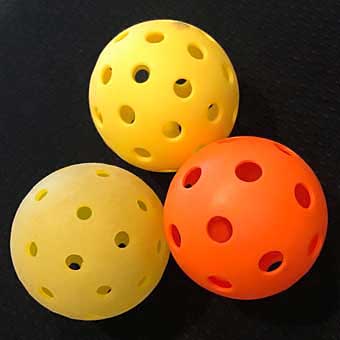Guide To Pickleball Balls
Indoor & Outdoor Pickleball Balls

Pickleball Balls
There are two basic types of pickleball balls, indoor and outdoor. Outdoor balls are heavier than indoor balls and have more holes (typically 40), they are typically yellow or chartreuse. Indoor balls are lighter than outdoor balls with fewer holes (typically 26), they are generally orange, with color variations ranging from light orange, to dark orange, or redish-orange.
When it comes to playing pickleball, the right equipment can make all the difference. While the paddle is certainly important, the ball you choose to play with can also have a significant impact on your game. Here, we'll explore some key factors to consider when choosing the right pickleball balls.
Pickleball balls are a crucial component of the sport, providing the means for players to engage in fast-paced rallies and showcase their skills. The design and characteristics of pickleball balls are essential in determining the game's speed, bounce, and overall playability.
Pickleball balls are made of plastic and feature a unique perforated design, similar to that of a wiffle ball. These perforations or holes help reduce the ball's speed and create an unpredictable flight pattern, adding an element of excitement and strategy to the game. The number and distribution of the holes can vary, with different ball models offering varying flight characteristics.
There are specific types of pickleball balls designed for indoor and outdoor play. Indoor balls are optimized for gymnasium or indoor court settings. They are typically lighter and have smaller holes compared to outdoor balls. These characteristics result in a slower ball speed and a more controlled bounce, making them well-suited for the smoother indoor surfaces. The slower pace allows for longer rallies and enhances shot placement and precision.
Outdoor pickleball balls, on the other hand, are designed to withstand rougher outdoor surfaces such as asphalt or concrete. They are generally heavier and have larger holes, which contribute to a faster ball speed and higher bounce. Outdoor balls are engineered to provide greater durability, with reinforced plastic construction to withstand the harsher playing conditions. The increased speed and bounce of outdoor balls accommodate the faster pace and unique challenges of playing on outdoor courts, where wind and surface irregularities may come into play.
The choice of pickleball balls depends on various factors, including the playing environment, skill level, and personal preference. Some players may prefer a particular brand or model based on its flight characteristics, durability, or the feel it provides during play. Trying out different balls and adjusting to their unique properties can help players find the ideal ball for their style of play and playing conditions.
As pickleball continues to gain popularity, manufacturers are constantly refining ball design and materials to enhance the playing experience. Innovation in ball technology is expected to result in improved durability, consistency, and flight characteristics, catering to the evolving needs of players at all levels.
It's worth noting that tournament play often mandates the use of specific ball models approved by the governing bodies of the sport. These approved balls ensure consistency and fairness in competition, as all players are using the same type of ball.
In conclusion, pickleball balls play a vital role in the sport, impacting the speed, bounce, and overall playability of the game. The unique perforated design, along with variations in weight, hole size, and construction, contribute to the diverse characteristics of pickleball balls. Whether it's the slower, controlled flight of indoor balls or the faster, more lively nature of outdoor balls, finding the right ball for the playing environment and personal preferences enhances the overall pickleball experience.
Indoor vs. Outdoor
The first thing to consider when choosing pickleball balls is where you'll be playing. Indoor and outdoor balls are designed differently, and using the wrong type of ball can affect your game. Indoor balls are usually made of a softer plastic and have smaller holes than outdoor balls, which are made of a harder plastic and have larger holes to account for wind resistance. If you're playing indoors, choose indoor balls, and if you're playing outdoors, go for outdoor balls.
Durability
The durability of the ball is another important factor to consider. Pickleball balls can range from very soft to very hard, with softer balls being less durable and harder balls lasting longer. However, harder balls can also be more challenging to control, especially for beginners. If you're new to the sport, you may want to start with a softer ball and work your way up as you become more comfortable.
Color
Pickleball balls come in a variety of colors, with yellow being the most common. However, some players may prefer other colors, such as orange or green, depending on their personal preferences and the lighting conditions in their playing area. It's important to choose a color that you can easily see and track during gameplay.
Brand
Finally, consider the brand of the pickleball balls. While there are many different brands on the market, some are known for producing higher quality balls than others. Look for a brand with a good reputation and positive reviews from other players.
Pickleballs
Out West Sport Pickleball Balls
There are no official restrictions on color, except that they must be a consistent, single color. An official pickleball ball weighs from .780 to .935 ounces. The diameter of an official pickleball ball is 2.874 to 2.972 inches.
Choosing the right pickleball balls is an important part of playing the game. Consider factors such as indoor vs. outdoor, durability, color, and brand when making your decision. With the right balls, you can enjoy this fun and exciting sport to its fullest and improve your game at the same time.
